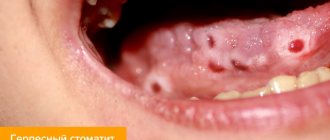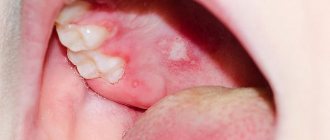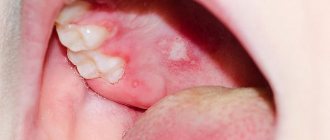How is herpes transmitted to children?
The herpes virus is very common and lives in almost all living things. It is transmitted by airborne droplets and contact . Once the herpes virus enters the body, it remains there for life. However, it can be in a “sleeping” state and not bother a person. If the herpes virus in a child has made itself felt, parents need to pay attention to this problem, because some herpes infections can take forms that are dangerous to health.
Children become infected with the herpes virus more often than adults, but overprotecting a child from infection is pointless and harmful. immunity to it . But the body is safe only in a situation where the infection is easy and without complications.
Types of herpes in infants
For babies in the first year of life, herpes comes in different types. The forms in which the herpes virus manifests itself are as follows:
- generalized;
- neurological herpes in newborns;
- localized.
In the first case, the generalized form of herpes in infants has the following clinical picture. The virus affected the internal organs and led to intoxication. The baby has difficulty breathing, he may vomit and belch, and the fever can sometimes be very strong.
With the neurological form of herpes, the virus spreads its influence to the nervous system and brain. If the infection occurred in utero, the child may have the following deviations from normal development: microcephaly, hydrocephalus, and the formation of calcifications. Symptoms here vary and are not always typical. The newborn baby appears lethargic or cries incessantly. In addition, the baby may experience a swollen fontanelle and convulsions. Localized herpes in infants. The virus appears in limited places on the child's body. These are the eyes, nasolabial area, etc.
In addition, herpes can be primary or secondary. Primary herpes in newborns can be a consequence of infection of the baby's mother during pregnancy. In addition to transmission of the virus through the placenta, the infection can be transmitted to the fetus during childbirth, when the baby passes through the birth canal. The method of entry of the herpes virus can also be domestic. A baby can become infected with the disease through the belongings of other children or through airborne droplets, as well as from parents.
How does secondary herpes develop? When an infection has entered the body of a newborn, it may not immediately manifest itself. The virus is suppressed by antibodies that the baby's mother transmits to him along with milk during breastfeeding. If the baby’s immune defense decreases, the herpes virus will be activated. In this case, the infection will spread throughout the body, approaching the skin and mucous membranes; visual manifestations of herpes will be visible as a specific rash.
The worst thing is if herpes in infants occurs on the genitals. In this case, the virus can infect the bladder and ureter. Also, such herpes, and it is called genital, can affect important internal organs, including the heart.
Types of disease in children
There are 80 types of herpes virus, of which 8 are dangerous to humans. The nature of the disease and the type of herpetic rash depend on the type of herpes simplex virus (HSV):
- Type 1 HSV - looks like cold-like rashes in the form of blisters on the lips, causes herpetic stomatitis and herpetic encephalitis.
- Type 2 HSV – manifests itself as a rash on the genitals (genital herpes).
- Type 3 HSV – causes chickenpox and recurrent herpes zoster.
- The 4th type of HSV - Epshane-Barr virus, causes malignant lymphoma and infectious mononucleosis - an acute viral disease with fever, damage to the respiratory tract, lymph nodes, liver, spleen and blood.
- Type 5 HSV – cytomegalovirus; affects the respiratory system, internal organs, intestines, eyes, brain, nervous and urinary systems.
- Type 6 HSV - causes viral eczema - exanthema - pseudorubella-type rash;
- The 7th and 8th types of HSV have not been sufficiently studied. Source: A.G. Lateral Herpesvirus infections in children - an urgent problem of modern clinical practice // Children's infections, 2010, No. 2, pp. 3-7
Herpesvirus infections in children: modern treatment options
In recent years, herpes viruses have occupied a special place among the main causative agents of viral infections in children, which is associated with their widespread distribution, wide diversity, multiple organ lesions, variety of clinical manifestations, as well as a high frequency of chronicity. Herpes-associated diseases are among the most common and poorly controlled human infections. This is due to the fact that herpes viruses can circulate for a long time asymptomatically in the body of a person with a normal immune system, and with immunosuppression, contribute to the development of severe diseases, including life-threatening generalized infections. Thus, according to the World Health Organization (WHO), the mortality rate from herpes infection is about 16% and is in second place after hepatitis among viral diseases [1].
Herpes viruses (from the Greek ?ρπειν (herpein) - to crawl) are a family of DNA viruses, united in the Herpesviridae family, which includes 8 classified types of human viruses: herpes simplex viruses - herpes simplex virus (HSV-1) and genital herpes (HSV-2), varicella-zoster virus, Epstein-Barr virus, cytomegalovirus, human herpes virus types 6, 7, 8, as well as about 80 unclassified human and animal herpes viruses. The subfamily of α-herpes viruses includes HSV-1, HSV-2 and varicella zoster virus, which are characterized by rapid replication in various cell types and have a cytopathic effect on infected cell cultures. Beta herpes viruses (cytomegalovirus, herpes viruses types 6 and 7) also affect various types of cells, lead to an increase in their size (cytomegaly), and can contribute to the development of immunosuppressive conditions. The subfamily of γ-herpes viruses includes Epstein–Barr virus and herpes virus type 8 - Kaposi's sarcoma-associated virus (KSHV). They are characterized by tropism for lymphoid cells (T- and B-lymphocytes), in which they can persist for a long time. In some cases, they can cause the development of lymphoma and sarcoma [2].
For the synthesis of viral proteins and the formation of the virus envelope, its capsid and the DNA of “daughter” virions, amino acids, lipoproteins and nucleosides of the host cell are required. As intracellular reserves are depleted, these molecules enter the infected cell from the interstitial spaces. Due to the fact that herpes viruses directly depend on the intensity of intracellular metabolism in the human body, they colonize predominantly the cells of the epithelium, mucous membranes, blood and lymphoid tissue, which have the highest metabolic rate.
Virions of herpes viruses are thermolabile - they are inactivated within 30 minutes at a temperature of 50–52 °C, within 20 hours at a temperature of 37.5 °C, but tolerate lyophilization well. On metal surfaces (coins, door handles, water taps) herpes viruses survive for 2 hours, on plastic and wood - up to 3 hours, on wet medical materials (cotton wool and gauze) - until they dry at room temperature (up to 6 hours ). The uniqueness of herpes viruses lies in the fact that they are capable of continuously or cyclically multiplying in infected cells of tropic tissues (persistence), as well as being preserved for life in a morphologically and immunochemically modified form in the nerve cells of regional nerve ganglia (latency) and being reactivated under the influence of various exogenous agents. and endogenous provoking factors. However, the ability for persistence and latency varies among different strains: the most active in this regard are herpes simplex viruses, the least active is the Epstein-Barr virus.
According to numerous studies, by the age of 18, more than 90% of urban residents are infected with one or more strains of viruses. The main route of infection is airborne, through direct contact or through household items (shared dishes, towels, handkerchiefs, etc.). Oral, genital, transfusion, transplantation and transplacental routes of transmission of infection are also noted. HSV types 1 and 2, cytomegalovirus are among the causative agents of TORCH infections, contributing to the development of serious diseases in newborns and young children. Herpes simplex viruses, cytomegalovirus, and Epstein–Barr virus are considered indicators of AIDS due to their frequent detection in this disease [3, 4]. The development of chronic fatigue syndrome (CFS) is associated with herpes viruses [5].
Clinically, herpes infection in children can occur in the form of chickenpox (varicella-zoster virus), infectious mononucleosis (Epstein-Barr virus), sudden exanthema (human herpes virus types 6 and 7), aphthous stomatitis (HSV 1 or type 2), mononucleosis-like syndrome (cytomegalovirus). In adolescents and adults, the infection is often asymptomatic, which is explained both by the biological properties of the strains and by the individual characteristics of the immune response. Often, when the body’s immunoreactivity decreases, herpes viruses act as opportunist viruses, leading to a more severe course of the underlying disease and the development of complications. The role of herpesvirus infections, especially cytomegalovirus, in the formation of infant mortality is great. The greatest threat to the life and health of children is posed by herpetic neuroinfections - their mortality rate reaches 20%, and disability - 50%. Ophthalmoherpes (development of cataracts or glaucoma - up to 50%), genital herpes, and a generalized form of Epstein-Barr virus infection (infectious mononucleosis) are severe [1, 6].
Herpes virus infection is a difficult to control disease. Despite the variety of medications used to treat this pathology, there is no means of providing a complete cure. This is due to the genotypic characteristics of the pathogen, the formation of resistance of herpes viruses and molecular mimicry.
The mechanisms of replication of herpes viruses discovered using molecular biology methods, as well as the study of the interaction of the virus with the cell, have made it possible to create a number of effective chemotherapeutic agents with antiherpetic activity. However, while effectively stopping acute manifestations of infection, they do not prevent relapses and do not always reduce the frequency of relapses.
Considering that with herpes-associated infections, as with other chronic diseases with long-term persistence of the virus, immunodeficiency states develop, in order to increase the effectiveness of treatment, treatment regimens, along with antiviral drugs, must include drugs that help correct the patient’s immune status. All this dictates the need to correctly select the drug, its dose and duration of administration, and, if necessary, use a combination of different drugs, while avoiding polypharmacy. A certain complexity of therapy in childhood is caused by age restrictions for a number of drugs, the presence of adverse drug reactions (ADRs) and contraindications.
Currently, the following groups of drugs are used to treat herpesvirus diseases and prevent relapses (table).
When treating herpes infections, an integrated approach should be followed. The duration and intensity of therapy are determined by the patient’s age, the clinical form of the disease, the severity of its course, as well as the presence of complications and concomitant pathologies. Treatment and preventive measures should be divided into several stages.
- Acute period of illness (relapse) - protective regimen, therapeutic nutrition, antiviral drugs, interferons and their inducers. According to indications, immunoglobulins, antibacterial drugs of local and systemic action, glucocorticoids, neuro- and angioprotectors, hepatoprotectors, cardiotropic drugs, protease inhibitors are prescribed. Symptomatic therapy may include antipyretic, expectorant and mucolytic drugs.
- Remission, subsidence of the main clinical manifestations (immunomodulators, adaptogens of plant origin, pre- and probiotics, vitamin-mineral complexes).
- Prevention of relapses (specific prevention - vaccination, sanitation of chronic foci of infection, restoration of immune status, etc.).
It should be noted that the combined use of antiviral drugs and immunobiological agents has a number of advantages. Firstly, complex therapy provides a synergistic effect. Secondly, it allows you to reduce the dose of an antiviral chemotherapy drug, reducing the likelihood of developing ADRs, reducing its toxic effects on the body and reducing the likelihood of the emergence of resistant strains of herpes viruses. In addition, it significantly reduces the duration of the acute period of the disease and the treatment time.
One of the drugs that has shown its effectiveness in the treatment of herpes-associated diseases in children is inosine pranobex. Inosine pranobex is a synthetic complex purine derivative with immunostimulating activity and nonspecific antiviral effect. The drug restores the functions of lymphocytes in conditions of immunosuppression, increases blastogenesis in the population of monocytic cells, stimulates the expression of membrane receptors on the surface of T-helpers, has a stimulating effect on the activity of cytotoxic T-lymphocytes and natural killer cells, the functions of T-suppressors and T-helpers, increases the production of immunoglobulin G, interferons, interleukins (IL-1 and IL-2), reduces the formation of proinflammatory cytokines (IL-4 and IL-10), potentiates the chemotaxis of neutrophils, monocytes and macrophages. The mechanism of the antiviral action of the drug is associated with the inhibition of viral RNA and the enzyme dihydropteroate synthetase, which is involved in replication, enhancing the synthesis of lymphocyte mRNA suppressed by viruses, which is accompanied by inhibition of the biosynthesis of viral RNA and the translation of viral proteins.
Inosine pranobex is low toxic, well tolerated, in Russia it is recommended in the form of tablets for children from 3 years of age (body weight more than 15 kg). Abroad, it is also available in syrup form and has no age restrictions. The drug is prescribed at 50–100 mg/kg/day orally in 3–4 doses throughout the entire acute period of the disease (5–10 days, depending on the duration of viremia and the severity of the intoxication syndrome). As maintenance therapy to restore immunological parameters, it is possible to prescribe the drug according to an immunomodulatory regimen (50 mg 2 times a day for 14–28 days). The high effectiveness of course therapy with inosine pranobex (50 mg/kg body weight per day in 3-4 doses orally, three courses of treatment for 10 days with an interval of 10 days) [7], combined course therapy using inosine pranobex and recombinant interferon α- 2β (3 courses of 10 days with an interval of 14 days) in children with mixed viral infections [8].
The use of inosine pranobex as a drug with immunotropic and antiviral effects at various stages of treatment and prophylactic measures allows one to avoid polypharmacy, thereby reducing the drug burden on the body and reducing the risk of undesirable effects.
Literature
- Kuskova T.K., Belova E.G. The family of herpes viruses at the present stage // Attending Physician. 2004, No. 5, p. 64–69.
- Hjalgrim H., Askling J., Rostgaard K. et al. Characteristics of Hodgkin's lymphoma after infectious mononucleosis // N. Engl. J. Med. 2003; 349:1324–1332.
- Nikolsky I. S., Yurchenko V. D., Nikolskaya K. I. Characteristics of active chronic Epstein–Barr viral infection: clinical and immunological syndrome // Modern infections. 2003, No. 3, p. 60–62.
- Katz BZ, Shiraishi Y., Mears CJ, Binns HJ, Taylor R. Chronic fatigue syndrome after infectious mononucleosis in adolescents // Pediatrics. 2009, Jul; 124(1):189–193.
- Lerner AM, Begar SN, Deeter RG IgM serum antibodies to Epstein-Barr virus are uniquely present in a subset of patients with the chronic fatigue syndrome // In Vivo. 2004, Mar-Apr; 18 (2): 101–106.
- Maakaroun NR, Moanna A., Jacob JT, Albrecht H. Viral infections associated with haemophagocytic syndrome // Rev. Med. Virol. 2010, Mar; 20 (2): 93–105.
- Simovanyan E. N., Denisenko V. B., Grigoryan A. V. The effectiveness of the use of inosine pranobex in frequently ill children with chronic Epstein-Barr viral infection: results of a randomized study // Issues of modern pediatrics. 2011, T. 10, No. 2, pp. 16–21.
- Nesterova I. V., Kovaleva S. V., Chudilova G. A., Lomtatidze L. V., Kleshchenko E. I., Shinkareva O. N. Dynamics of changes in the phenotype and functional activity of neutrophil granulocytes in immunocompromised children with repeated acute respiratory viral infections, associated with herpesvirus infections, against the background of combined interferon and immunotherapy // Cytokines and inflammation. 2014, T. 13, No. 1, p. 113.
T. A. Bokova, Doctor of Medical Sciences, Professor
GBUZ MO MONIKI named after. M. F. Vladimirsky, Moscow
Contact Information
Virus activity
Most often, children are faced with the herpes simplex virus, which manifests itself in the form of that same cold on the lips.
Herpes on the lips or chickenpox are not as dangerous for a child as herpetic lesions of the eyes, genitals, and internal organs.
Externally, herpes appears as a rash on the skin or mucous membranes. It usually looks like small blisters that eventually burst and become sores. In addition to the rash, there is burning and itching.
How often the herpes virus is activated is influenced by hereditary predisposition and the state of the immune system. The weaker the child’s immunity, the more susceptible he is to virus attacks.
Newborns up to 1 year of age are protected by maternal antibodies. The peak incidence is observed at the age of 2-3 years. By the age of 15, up to 90% of adolescents are infected with HSV. The pathogen is in an inactive state in the body and does not cause discomfort. Under unfavorable conditions, HSV is activated. Source: A. Taieb, N. Diris, F. Boralevu, C. Labreze Herpes simplex in children. Clinical manifestations, diagnostic value of clinical signs, clinical course // Ann Dermatol Venerol, 2002, v.129, No. 4, p.603—608
Causes of exacerbations and relapses of herpes in children:
- decreased immunity due to severe and prolonged illnesses;
- severe shocks and chronic stress;
- systematic fatigue;
- hypothermia;
- taking hormonal medications;
- endocrine pathologies;
- hormonal changes in adolescence;
- systematic unbalanced diet;
- complicated seasonal colds;
- chemical and radiation anticancer therapy;
- excessive physical activity. Source: M.N. Kankasova, O.G. Mokhova, O.S. Pozdeeva Frequently ill children: the view of an infectious disease specialist // Practical Medicine, 2014, No. 9(85), pp. 67-71
Pediatrician Mikhail Nikolsky: Herpes - to treat or not to treat
Alexandra Petrovskaya: Good afternoon. This is a program for the biggest ones. With us in the studio is pediatrician and candidate of medical sciences Mikhail Nikolsky. Mikhail Andreevich, hello.
Mikhail Nikolsky: Good afternoon.
A.P.: We have gathered here today about your scientific work on herpes types 6 and 7. Let's try to explain to the listeners what it is, and, most importantly, where these types come from, and what other types - the first, second, third and so on - go up to 6 and 7.
M.N.: In total, there are 8 or 9 types of herpes, depending on how you count. The first and second types are common herpes, which causes cold sores on the lips. The third type is the herpes zoster virus, which causes chickenpox or shingles in adults.
A.P.: So what we call chickenpox is, in fact, the same herpes?
M.N.: Not the same, it’s a completely different herpes, but also herpes.
A.P.: By what principle are they all united under this name?
M.N.: It's difficult. When scientists studied the DNA of these viruses, it turned out that they all had similar related features. The fourth type, Epstein-Barr virus, causes infectious mononucleosis. The fifth type is what everyone knows as cytomegalovirus. These are also often infections, mostly for children.
And finally, type 6 and 7 are what I do. Most often they cause roseola in children - a three-day fever or sudden exanthema. Next comes the eighth type of herpes, it occurs in Kaposi's sarcoma. This is a serious disease that predominantly occurs in HIV-infected patients.
A.P.: Besides the common name and some similarities in DNA, what else unites them? Maybe there are common methods of therapy or similar effects of the virus on the body?
M.N.: Firstly, unlike many other viruses, there is a medicine against herpes. This is what makes these viruses different from others in many ways because there are no cures for a huge number of viruses.
A.P.: What about all these fashionable antiviral drugs that are advertised everywhere?
M.N.: Everything that is advertised on TV is, unfortunately, most likely fake.
A.P.: Fakes are prohibited.
M.N.: Fakes are prohibited, but, apparently, advertising of drugs without proven effectiveness is allowed.
A.P.: This is a topic for a separate program.
M.N.: This is a problem for our country, because in our country fakes have even found their way into clinical recommendations. And we treat people with all these “bullshit drugs.” Moreover, we are obliged to treat them, because we have appropriate clinical recommendations.
A.P.: Is someone lobbying for this?
M.N.: Of course, this is lobbied for, it is paid for. And what to take if, excuse me, we have one of the members of the Russian Academy of Sciences - a homeopath.
A.P.: In these words you can feel your contempt for homeopathy.
M.N.: From the point of view of a clinical physician, to some extent, yes, contempt, this is true.
Let's return to herpes. They have a unique feature. After a person becomes ill with a primary herpes infection, these viruses do not leave the human body. All herpes that a person encounters in life remain with him forever.
A.P.: I came across the statement that it is difficult to meet a person on Earth over 10 years old who does not have antibodies to one or another type of herpes.
M.N.: And not only antibodies, but even the herpes themselves. In almost all people after a certain age, one or another herpes can be found in saliva, blood or other tissues. This is the problem with diagnosing them - doctors very often get confused. Colleagues, out of ignorance, but with the best intentions, prescribe, for example, saliva tests for frequently ill patients for the Epstein-Barr virus, cytomegalovirus, herpes type 6, type 7, and find them in the saliva. And this is the norm.
A.P.: Are they starting to treat?
M.N.: Yes, absolutely right. The patient does not know that this is the norm. He sees that he has a “terrible” test, that such and such a number of these herpes have been found, and the doctor, most likely, out of ignorance and lack of understanding of this problem, begins to treat normal carriers of herpes. And what does he treat? He treats with the same fuflomycins. And nothing happens.
A.P.: Bottom line – there is no need to treat herpes?
M.N.: It is necessary if it caused a serious illness - and all herpes in certain cases can cause serious illnesses. For example, herpes type 6 is a common cause of severe conditions in patients after a bone marrow transplant. If herpes after a bone marrow transplant has worsened against the background of a decrease, the actual destruction of one’s own immunity, then therapy necessarily requires powerful antiviral agents.
Well, take chickenpox – it would seem a harmless disease. But after 11 years it is difficult and can have consequences. Therefore, it is believed that if the patient is under 11 years of age, it often goes away on its own. And if you are over 11 years old, then it is better not to risk it, but to prescribe acyclovir.
A.P.: Is this a drug with proven effectiveness?
M.N.: Yes, it acts specifically on the chickenpox virus.
A.P.: It turns out that herpes, which is always in the body, at some point gets worse. For example, I heard about herpes type 6, that this is a typical disease for children under 2-3 years of age. It turns out that no.
M.N.: The fact is that herpes type 6 is the most common infection that always causes sudden exanthema or three-day fever or roseola. In principle, it is a very understandable infection: the child has a high fever for three days, then a typical maculopapular rash appears. Within two days it disappears on its own and the person recovers.
The infection itself can occur even through an ordinary kiss, as happens with many herpes. That is, the virus can enter the child’s body through contact with the saliva of the mother, grandmother, or any adult, who are usually the carrier of all herpes. And so the child suffers this primary infection through the human herpes virus type 6, and after that the human herpes type 6 remains in this child forever. And it won’t go anywhere, and there’s no way to get rid of it.
But it needs to be treated only in one situation - if it has caused some kind of serious illness, which almost never occurs in healthy people. Only for severe immunodeficiencies, which usually occur during organ and tissue transplantation. There are situations when intensive treatment of herpes type 6 is required.
In all other cases, there is no need to shock-treat it. And we must keep in mind that herpes is a very fashionable topic now. Herpes virus type 6 is easy to find, which means it can be presented for almost any disease as a possible diagnosis. And many doctors use this. For example: “I don’t know what’s wrong with you. Let’s look for what you definitely have.” And here is herpes type 6 - it definitely exists, and it is there.
A.P.: Another such moment. What other diseases can be associated with herpes viruses that are present in the body?
M.N.: As I already said, herpes types 6 and 7 “classically” cause roseola in children. Herpes type 6 and sometimes, but rarely, type 7 are also associated with febrile seizures in children. There are studies that show a connection between certain types of epilepsy and human herpes virus type 6. So it turns out that herpes type 6 actually causes a type of epilepsy.
A.P.: This virus is present in almost everyone’s body, but not everyone has epilepsy. That is, this suggests that there is no direct connection; there are other factors influencing the appearance of this disease?
M.N.: Of course, there are many factors here. For example, two people caught the same infection: but one had a runny nose, and the other had meningitis. But the infection is the same. Of course, there are many factors involved.
There was also a study that associated human herpes viruses 6 and 7 with other diseases, suggesting a link with multiple sclerosis. But this has not been proven. This is already a field of science, but we do not have clear indications that herpes is exactly what causes multiple sclerosis.
A.P.: During the program, we talked briefly about all herpes and outlined all the important points. And, concluding the conversation, I want to return to the beginning. What questions does science face today in this area?
M.N.: By the way, I forgot to say that a special form of human herpes type 6 is the chromosomal integrated form of this virus, when herpes type 6 is introduced into the human chromosome and begins to be inherited by all generations.
Now we have received a grant in St. Petersburg. We conduct free examinations of everyone for certain indications for the presence of chromosomally integrated human herpes type 6. It is precisely the presence of chromosomally integrated human herpes type 6 that may provide links with certain diseases. It turns out that almost 1% of the world's population has a chromosomally integrated virus built into its genome.
A.P.: Okay. Remembering my student years, what hypothesis do you have in this scientific research? If something, then what?
M.N.: We are currently recruiting a reference group, we are looking for people, we are examining them. I personally am now most interested in whether there are clinical manifestations of chromosomal integration of human herpes type 6 in newborns. In my opinion, this is the most interesting concept; no one in the world has yet developed this direction. So far there are preliminary results, but I’m not ready to announce them yet.
A.P.: Our guest was Mikhail Nikolsky, a pediatrician and candidate of medical sciences. Thank you and have a nice day everyone!
Treatment of herpes in children
It is impossible to eliminate the herpes virus from the body, so the goal of treatment is to reduce its activity , eliminate symptoms by activating the immune system, achieve stable remission and prevent complications.
The most effective medicine against most manifestations of the herpes virus in children is the substance acyclovir. Treatment uses both oral and local medications. Source: I.F. Barinsky, L.M. Alimbarova, A.A. Lazarenko, F.R. Makhmudov, O.V. Sergeev Vaccines as a means of specific immunocorrection for herpetic infections // Questions of Virology, 2014, pp. 5-11
A comprehensive treatment regimen for acute herpetic infection includes:
- antiviral-antiherpetic drugs - tablets, injections and ointments - based on acyclovir;
- surface antiseptics for the prevention of secondary bacterial infections;
- immune stimulants – herbal and interferon derivatives;
- multivitamins and vitamins in therapeutic doses;
- antipruritic antihistamines;
- antipyretics;
- hepatoprotectors – in case of severe intoxication;
- diet therapy with sufficient amounts of protein and exclusion of foods that are sources of arginine.
In severe general condition, bed rest is recommended. Only a doctor can decide how to treat herpes in a child.
Symptoms and localization of herpes in infants
Manifestations of herpes can be in different places of the newborn’s body. Depending on what type of herpes virus infected the baby, the distribution of manifestations will be different. So, we will tell you the symptoms in each case in order.
Simple herpesvirus type 1. The manifestation of infection on the lips of the newborn, as well as in the nasolabial area. The rashes are filled with liquid and are small in size. The liquid becomes cloudy over time, and the so-called blisters burst. In place of the burst blisters, wounds appear, which disappear after a while.
The second type, genital. Localization area: genitals, anus. The rashes are small and filled with liquid. The affected area itches and burns. There is also discomfort when emptying the bladder. Lymph nodes enlarge.
The third type is called chickenpox. The rash covers the entire body. They are present not only on the skin, but also on the mucous membranes. This herpes in infants is characterized by an increase in body temperature, the child looks lethargic and weak.
Herpesvirus type 4. If the form is uncomplicated, then there are no symptoms. With the development of infectious mononucleosis, the tonsils and palate are affected. The virus can infect the spleen and liver, and the composition of the blood changes. Symptoms: general malaise, apathy, weakness. In addition, the child has a stuffy nose, a sore and red throat. Lymph nodes become larger in size. The rashes are pinpointed, they look like tiny hemorrhages or pink blisters on swollen skin.
Fifth type. In most cases there are no symptoms. However, there are also characteristic manifestations of this type of herpes in a child. With cytomegalovirus mononucleosis, intoxication of the body begins. This is expressed in a sharp rise in temperature to 39 degrees, a sore throat, and the nasopharyngeal mucosa is red. In difficult cases, infants have pain when swallowing. The child has difficulty breathing, hearing partially or completely disappears. Sometimes internal organs are damaged.
Virus type six. Increased temperature, changes in lymph nodes. The rash is papular-spotty, pink in color. This herpesvirus can cause immunodeficiency in children.
Possible complications
Without timely and adequate treatment, herpes infection can cause severe complications:
- disruption of internal organs;
- eye diseases;
- deafness;
- sore throat;
- nervous and mental disorders;
- infertility.
Sources:
- A.G. Side. Herpesvirus infections in children - an urgent problem of modern clinical practice // Children's infections, 2010, No. 2, pp. 3-7.
- Taieb, N. Diris, F. Boralevu, C. Labreze. Herpes simplex in children. Clinical manifestations, diagnostic value of clinical signs, clinical course // Ann Dermatol Venerol, 2002, v.129, No. 4, p.603-608.
- M.N. Kankasova, O.G. Mokhova, O.S. Pozdeeva. Frequently ill children: the view of an infectious disease specialist // Practical Medicine, 2014, No. 9(85), pp. 67-71.
- I.F. Barinsky, L.M. Alimbarova, A.A. Lazarenko, F.R. Makhmudov, O.V. Sergeev. Vaccines as a means of specific immunocorrection for herpes infections // Questions of Virology, 2014, pp. 5-11.
The information in this article is provided for reference purposes and does not replace advice from a qualified professional. Don't self-medicate! At the first signs of illness, you should consult a doctor.
Prices
| Name of service (price list incomplete) | Price |
| Appointment (examination, consultation) with a dermatovenerologist, primary, therapeutic and diagnostic, outpatient | 1750 rub. |
| Consultation (interpretation) with analyzes from third parties | 2250 rub. |
| Prescription of treatment regimen (for up to 1 month) | 1800 rub. |
| Prescription of treatment regimen (for a period of 1 month) | 2700 rub. |
| Consultation with a candidate of medical sciences | 2500 rub. |
| Dermatoscopy 1 element | 700 rub. |
| Setting up functional tests | 190 rub. |
| Excision/removal of cutaneous/subcutaneous elements and formations (1 element) | 2550 rub. |
| Removal of milia of one unit using electrocoagulation | 350 rub. |











